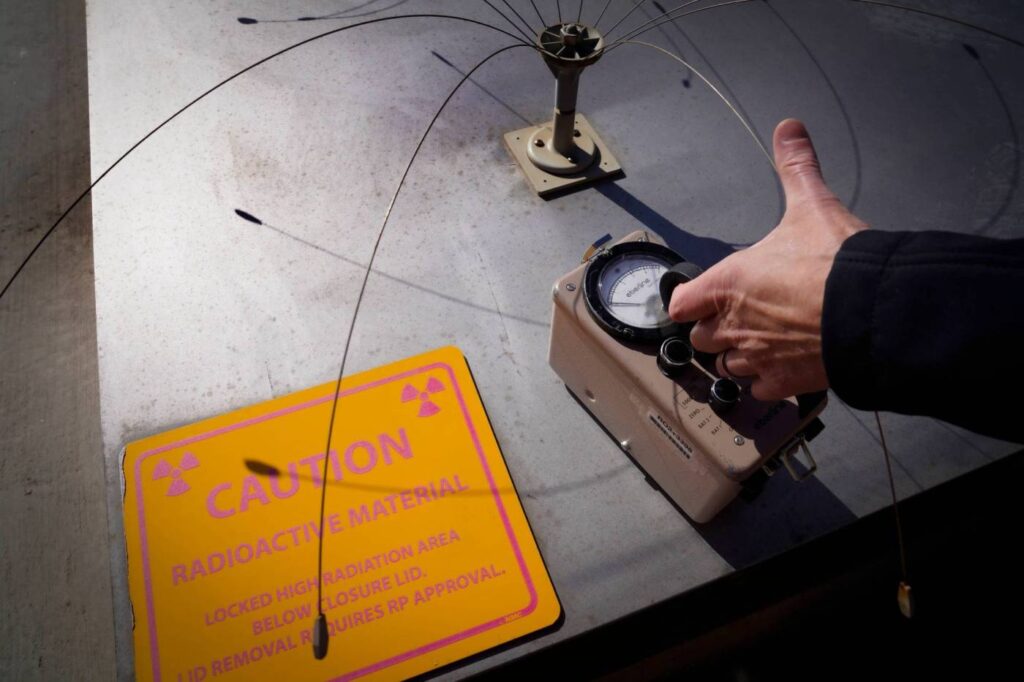
The San Onofre Nuclear Generating Station in 2019. (Photo by Leonard Ortiz, Orange County Register/SCNG)
Elevated levels of tritium — a radioactive form of hydrogen — have been found at the shuttered San Onofre Nuclear Generating Station, but pose no risk to public health or safety, officials from Southern California Edison said on Thursday, Sept. 5.
The Environmental Protection Agency has set a “maximum contaminant level” of 20,000 picocuries per liter for tritium in drinking water. Routine monitoring at San Onofre found a low concentration of 3,430 picocuries per liter in one well, and a higher concentration of 19,100 picocuries per liter in an adjacent well.
Neither, however, is a drinking water well, officials said.
The plant is just yards from the ocean, so groundwater beneath and around it is salty. It typically flows east to west — that is, inland toward the ocean — and wouldn’t enter the drinking water supply, said Ron Pontes, Edison’s decommissioning manager.
Excavators demolish the control building at San Onofre Nuclear Power Plant on Aug. 1. (Nelvin C. Cepeda / The San Diego Union-Tribune)
“We’re bringing this up now so you know we’ve got an issue here, we’re aware of it, monitoring it, taking action,” Pontes told the Community Engagement Panel at its quarterly meeting. “We’ve engaged a hydrogeologist so we can understand the spread of this tritium, where it is exactly, and how to mediate it,” he said.
It’s not the first time tritium has been found at the site. In 2006, it prompted the temporary closure of one drinking water well in southern Orange County (tests revealed no detectable radioactivity and the well was returned to service); in 2009, it was found in the ocean off the coast and in groundwater protection wells (attributable to sampling shortly after a planned discharge of filtered wastewater from the plant); and in 2012, pumps extracted tritium water from near Unit 2 (pumps were shut off in 2015 and there was no rebound of tritium in that area, Pontes said).
Dry storage of spent fuel at the San Onofre Nuclear Generating Station in 2021. (Photo by Jeff Gritchen, Orange County Register/SCNG)
Small tritium leaks were common at aging nuclear plants, but the health and safety threats of such leaks were characterized as “next to zero,” an investigation by the Associated Press reported more than a decade ago. A person could drink 130 gallons of the most radioactive water found beneath San Onofre in 2006 and still have no cause for health concern, the Nuclear Regulatory Commission said at the time.
The new findings are so low that reporting isn’t required, but Edison made courtesy notifications to federal, state and local authorities nonetheless, spokesman Jeff Monford said. It will also be monitoring wells more frequently as it decides how to proceed.
Tritium is a byproduct of nuclear reactions, but it’s also produced naturally when cosmic rays collide with nitrogen molecules in the upper atmosphere, the EPA says. It’s used to make luminous dials, as a source of light for exit and similar safety signs, and as a tracer for biochemical research, animal metabolism studies and groundwater transport measurements.
A radiological monitoring program mandated by the NRC requires Edison to test the environment surrounding the plant, including ocean water, sediment and beach sand. The NRC’s threshold for tritium in an ocean water sample that prompts reporting is 30,000 picocuries per liter, and San Onofre’s findings remain well below this level, Monford said.
Pontes also provided more detail on two self-reported, low-level violations revealed in a recent NRC inspection report of San Onofre. The first involved a “failure to ensure a package for shipment was leakproof and properly closed and sealed to prevent release of radioactive content as required by U.S. Department of Transportation regulations,” and the second involved a “failure to ensure, by examination or appropriate tests, that the packaging for the Unit 2 pressurizer (main function: to keep reactor’s coolant below boiling) was proper for the contents being shipped as required by DOT regulations.”
“Weep holes” in a pressurizer were blocked, Pontes said, so about 190 gallons of radioactive water remained inside when it should have been dry. New protocols will ensure that doesn’t happen again, he said.
The panel got an update on demolition progress — still on track for finishing up in 2028, more or less — and, as always, there was spirited discussion about the ocean releases of wastewater from the plant. Those releases have been happening regularly for decades, and are smaller now than they were when the plant was actively splitting atoms. Nearly 1 million gallons have been released so far this year, and another 850,000 gallons are slated to be released by the end of the year, Edison said.
Dan Stetson, volunteer chair of the Community Engagement Panel, thanked Edison for “a robust discussion.” The next meeting is slated for December.
